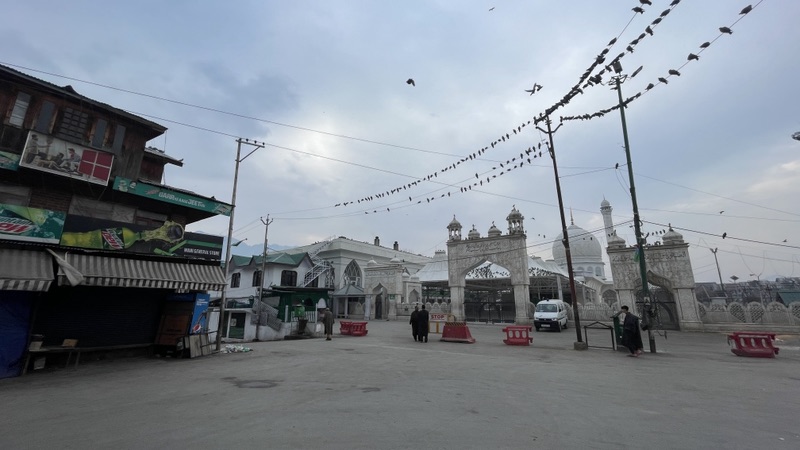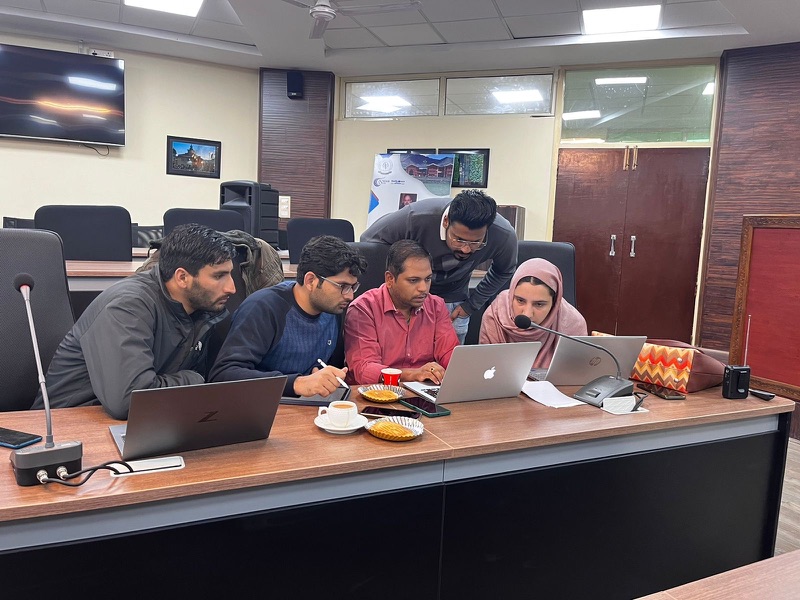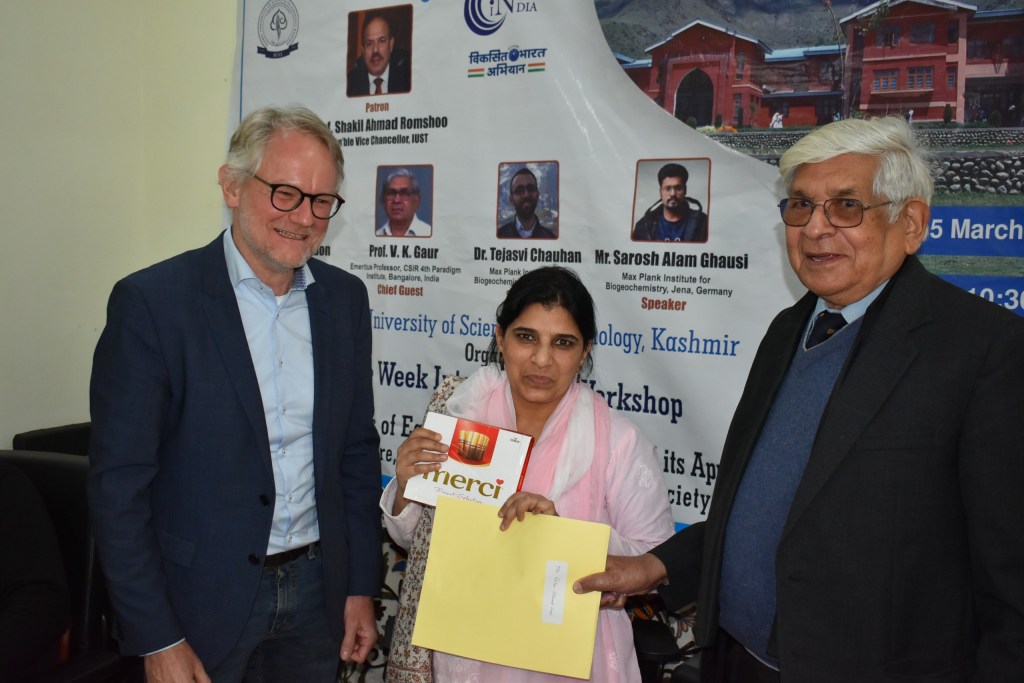Our last stop is Kashmir, where we hold a weeklong workshop on thermodynamics and optimality in climate, water cycle, ecosystems, renewable energy and sustainability. We have intense and stimulating interactions, hands-on sessions organized by Sarosh and Tejasvi, and an excursion into the mountains.
We arrive Sunday afternoon at the airport, I need to register, we get Indian SIM cards that work in Kashmir, and we get transferred into the guest houses. The traffic here is typical indian-style, except with a larger presence of army and police, partly due to its delicate, strategic position next to Pakistan and China. Vinod and I stay in the guest house of Kashmir, a place I know from last year’s visit and which is about an hour away from the Islamic University of Science and Technology (IUST) in Awantipora, while Sarosh and Tejasvi use a warden flat at IUST.
Day 1: Opening and the basics of thermodynamics
The first day I started with a run along the lake in the early morning around sunrise. The imans call for prayers, there is hardly any traffic, it is all so pretty and peaceful, helping my mind to focus on today’s lecture and the coming week.

Our event starts in the morning. After the opening ceremony by Vice Chancellor Prof. Romshoo and a few words of welcome from myself and Vinod, we start with an introduction of the basics of thermodynamics by Vinod. He described how widely thermodynamics applies, because energy conversions are so central to just about everything in the world around us and covers the basics such as entropy and Clausius’ fundamental relation.

After the lunch break, I describe how thermodynamics applies to the Earth system (if you want to read more, here is the link to a recent paper of mine on the topic). I first cover how entropy evolved to become a central concept of quantum physics, so that it has a much wider applicability than just heat. At the microscopic scale, energy is partitioned into quanta distributed across photons, electrons, and molecules. Entropy is then needed to bring their distributions to the macroscopic scale of classical physics, yielding (at least) three different forms of entropy, associated with radiation, molecular configurations, and the well-known entropy associated with heat. This aspect has highly relevant implications: after all photosynthesis and photovoltaics are not heat engines, yet the second law nevertheless applies to them and needs considerations of radiation entropy.
We have short presentations by the participants so that we all know what their backgrounds are and what they are interested in.
In the evening, we have a nice dinner in Srinagar in a small group, with Vinod, Sarosh, Tejasvi and Prof. Romshoo. And we experience different kinds of tea – salty tea with bicarbonate, slightly pink and milky in color, although it was not my favorite choice. We also had cups of Kahwa, a saffron tea with almonds, cardamom, and other spices and sweetened by honey – very nice!
Day 2: The atmosphere and climate
Today the lectures focused on the atmosphere and climate. I talked about how the spatiotemporal differences in radiative heating and cooling set up disequilibrium states in temperature that are used to generate power, with the resulting dynamics transporting heat, affecting temperatures, and thus feeding back to the power generation, resulting in a maximum of power that limits how much motion can be generated within the climate system.
This maximization applies to the vertical as well as to the horizontal, shaping surface temperatures as well as the large-scale circulation. I also discussed briefly modifications of the Carnot limit, e. g. when heat is advected by the atmosphere (like in the subtropics, see e.g., Sarosh’s recent paper on geographic variations), or due to heat storage variations during day and night (the “cold” heat engine).

After a brief tea break for the non-muslim participants (Ramadan has started today) and a group photo, Sarosh talks about applying maximum power to understand climatological temperature variations (his recent paper), variability and change – from the diurnal cycle to day-to-day variability and global warming.
The remainder of the day focused on hands-on sessions, where Sarosh and Tejasvi managed and supported exercises to actually see how maximum power applies to data for the Srinagar region.

For me and Vinod, a short overnight excursion into the mountains has been arranged. We left after the tea break and go to Pahalgam, a mountain village about 2 hours away. It lies in a valley where the Eurasian plate hits the Indian plate – and that’s also why Vinod is familiar with the area as he installed a seismic station here many years ago. We drive through the countryside, small villages, nice views on the mountains. It surely has an alpine flair, but with a muslim touch, with mosques (instead of chapels) in even the smallest villages.

After lunch in town, we went for a walk up the hill, to see town and the landscape. I talked to Saleem, an assistant professor in geoinformatics at IUST, and who works on a glacier nearby. Walk&talk – a wonderful way to discuss science, specifically how the surface energy balance and relative humidity should change with altitude.
Later in the afternoon – the sun has already set behind the mountains – I enjoy my tea on the balcony. It is cold, only a few degrees above zero, but I am prepared with enough clothing. I take my work material with me to prepare the next lectures, and enjoy the lovely atmosphere of a mountain river rushing past and seeing the forested mountains with snowy tops.

Before dinner, I had further stimulating discussion with Vinod over drinks in his room on many things, and how thermodynamics applies to so much more. And over the growing threat by populists, their fake science they spread, and how this will hinder us on moving forward to a better future for all.
Day 3: The hydrological cycle
The short course continued with the hands-on session. They worked well – students work and talk in groups together, discussing power and radiation in more detail. Meanwhile, I had an early start in the mountains. Like the other days, I get up around 5am and start with preparing lectures. I thought that I had already had a prepared version of this set of lectures, but there is always something new to add or to simplify. As the sun rose, I went out for a little walk up the hill and through the woods. It is lovely to be in the mountains and in nature, breathing the fresh crisp air of the morning.

After returning to IUST, the afternoon continues with a lecture on the thermodynamics of the hydrological cycle (based on our early work back in 2013, a book chapter, and novel stuff that is not yet published). A state of thermodynamic equilibrium is set by saturation – unsaturated air hence reflects disequilibrium. This disequilibrium is associated with evaporation taking place at the warmer surface, while the reverse phase transition of condensation takes place in the colder atmosphere.
We can further separate the hydrological cycle into an evaporation phase in which the disequilibrium is depleted, and a precipitation phase in which the disequilibrium is generated. Both phases involve work, and for both the power can be maximized. For evaporation, the maximization involves the buoyancy generation that brings the moistened air from the surface into the unsaturated atmosphere. Thermodynamics then yields an expression for potential evaporation that compares very well to observations if water availability at the surface does not constrain evaporation (see, e.g., this paper).
The precipitation phase is governed by the work done by a moist heat engine, that is fueled by the condensational heating. This engine performs the work of generating the updrafts within the cloud, and the work of dehumidification that results in unsaturated air. This view was then applied to understand the Hadley circulation, and can also be used to understand why precipitation events intensify and shorten with global warming.
Tejasvi then continued with a lecture in which he placed this description into the more common view of the hydrological cycle, discussed the changes with global warming, and ended with a quiz on what we have done so far – with chocolates as motivation for right answers.
After returning to the guest house, I went out and bought some fruit at the side of the street and Indian chocolates as essential nutrients for my life. Vinod, his brother and I enjoyed crackers with cheese and grapes before having dinner in the guest house. And like all other evenings, I sit down again at the laptop preparing more lectures…
Day 4: Renewable energy and the energy transition
Today we apply this thermodynamic view of the Earth system to renewable energy and the energy transition. After all, looking at power tells us the rates by which different forms of renewable energy are being generated, and a look at the energy transition shows us how the dissipation of energy by human societies can be reduced by using modern technologies.
The first lecture focused in renewable energy generation. We talked about why photovoltaics is so much more efficient because it uses low-entropy sunlight before it is thermalized into heat. The equivalent Carnot limit, derived using radiation entropy (see, e.g., here), is thus a lot higher. We also cover the so-called Shockley-Queissler limit, which is less, because there is a trade-off associated with the choice of band gap, which is a material property of the semiconductor that is being used. We look at the power associated with large-scale motion, and why wind turbines must become less efficient the more wind energy is used within a region because they deplete the atmospheric wind energy resource (see here). The relevance of this depletion effect is illustrated at the national level for Germany, e.g., for the offshore wind energy potential.
The second lecture dealt with the way we use energy (something I plan to publish sometime in the future). Many technologies we use today are based on combustion. Combustion is quite an inefficient way to do things. This is illustrated by the thermodynamic concept of the adiabatic flame temperature. This describes the maximum temperature at which chemical energy can be converted into heat. The release of heat by combustion is equated to the heat capacity of the gases that are produced. This temperature is very high, illustrating the high usability of chemical energy. Yet, when we want to use this energy to achieve what we want to use it for – e. g. cooking, showering, or heating rooms, we only need heat at a much lower temperature. In other words, most of the low entropy is actually wasted.
This waste can be avoided with modern technologies. A great example is our use of energy for lighting. A candle can produce light by combustion. The resulting soot particles are so hot that they emit some radiation in the visible spectrum, although most is emitted as infrared radiation. Light bulbs were a step forward, using electricity as the energy source, not combustion. Here, the filament enclosed in the glass is heated to higher temperatures. Hence, more of the emitted radiation is in the visible range. Even better are LEDs – they use a technology based on quantum physics where they only emit at the wavelengths that we want. Hence, these are far more energy efficient – and avoid combustion.
Similar efficiency increases can be achieved by electrifying mobility, room heating and hot water generation. Taken together, this modernisation can reduce the primary energy consumption by more than half.

In the afternoon we went on an excursion – again to Pahalgam. I joined the students in the bus to be able to talk more informally. Once we reached the town, we go on a walk up the hill, talk about science and take group pictures. We enjoy the views and the wonderful weather.

Our return trip is, in the end, in a rush. Some of us are muslims, and they need to break fast at sunset. We thus have a stopover in Anantnag, where we arrive just in time in front of a restaurant. While we step out, the muslim parts of us distributed dates to all, and we jointly ate those together – how nice!
Day 5: Biosphere, human societies, and sustainability
The last day of the short course has arrived. At sunrise, I get out again, running along the lakefront. On the way back I take a small detour to some house boats nearby, with the white mountain tops visible in the distance.

After a final hands-on session, I give two more talks. The first one is on the biosphere as a thermodynamic system. The disequilibrium here is represented by the simultaneous presence of reduced carbon (like carbohydrates) and atmospheric oxygen. We talk more generally about the basics of geochemistry, Le Chatelier’s principle, and the different ways by which the Earth system generates different forms of chemical free energy. Here, photosynthesis sticks out in terms of the magnitude of how much chemical energy is generated.
We continue with the thermodynamics of photosynthesis and what limits the natural rates (see e.g., here), fractal structures that minimize frictional dissipation (see e.g., the work by West and colleagues), and root systems that push the limits (see e.g., here). I describe how all these fit together, and what this would imply if we take this to the planetary scale and apply it to Earth’s history (see e.g. here).
After lunch (and the Friday prayers) I give the last lecture on the thermodynamics of human societies and what it means for sustainability (see e.g, here). The key idea here is that the main role of human societies is to consume food and primary energy – forms of energy that were generated by natural processes. We thus act as dissipative processes in the Earth system, at the expense of the natural system. We do not generate our own energy from the Sun.
Food production by agriculture removes chemical energy from what would have otherwise been consumed by natural dissipators, particularly the fauna. Hence it is no surprise that biodiversity is on the decline, and the natural biosphere is being depleted. Similarly, the huge consumption of fossil fuels means that we deplete a planetary disequilibrium state that life has created in form of reduced carbon compounds and atmospheric oxygen over millions of years over Earth’s history.
The way out is photovoltaics – it is the third way of converting sunlight into useful work, besides heat engines and photosynthesis. It is, however, far more efficient than natural processes, so if wisely used, it can make human societies as well as the whole planet sustainably more powerful.
Our event ends with a closing ceremony, with words of thanks and certificates for the participants. We say farewell, and some of us may meet again in the near future at the EGU next month.


